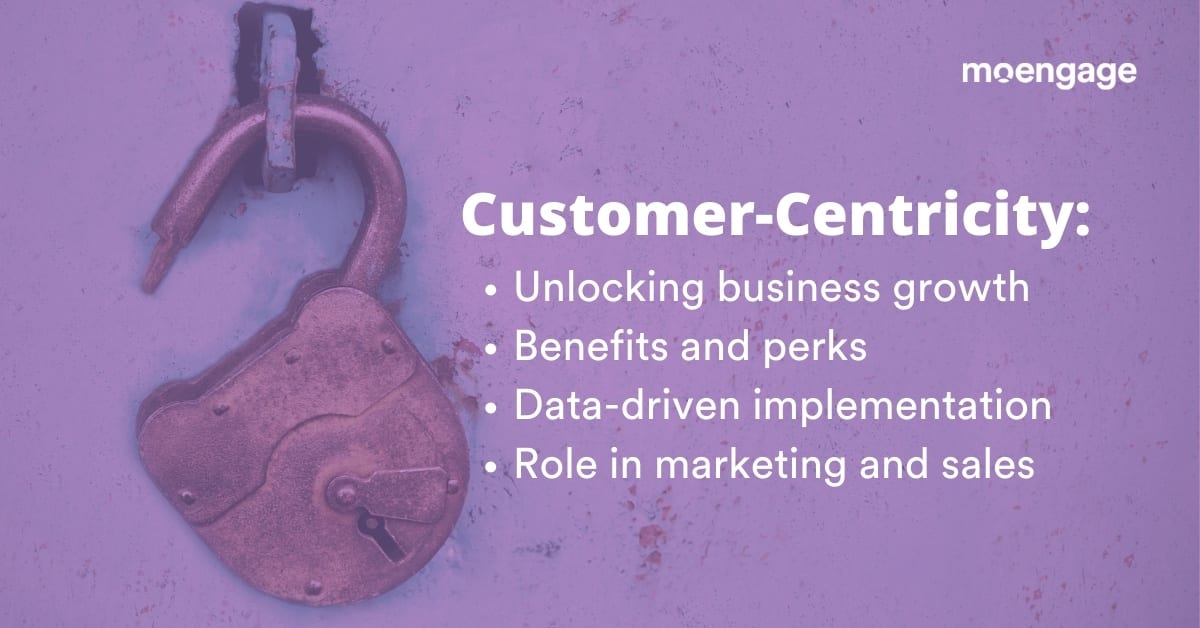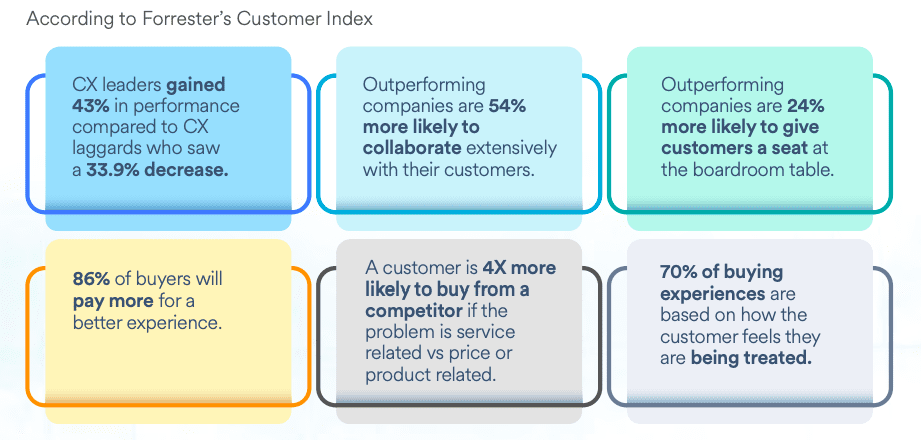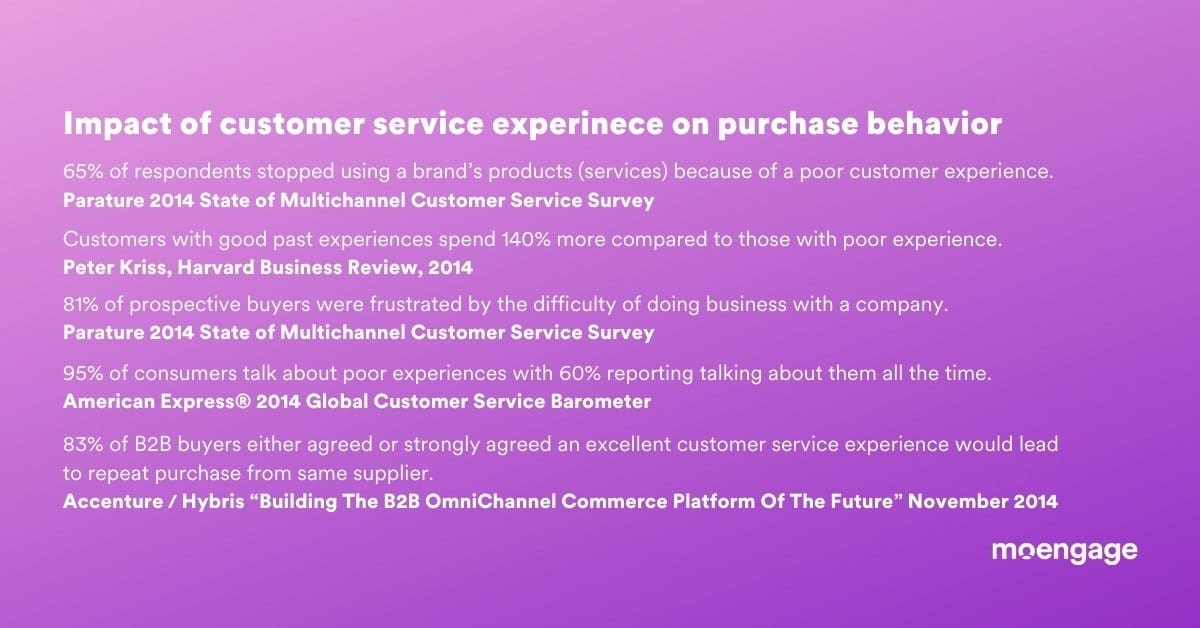Perks of Customer-Centricity and How a Data-driven Approach Can Help

Reading Time: 10 minutes
While customer-centricity is a mindset that needs to be nurtured and communicated across all levels of an organization, it is no mere mantra. It requires a conscious effort to keep the customer at the center of every decision and action. In short, there’s no seamless and quality customer experience without being customer-centric. In this article, we will discuss the perks of being customer-centric. If you want to understand how to transform your organization into a customer-centric one, check out out the 11 steps!
In a few short years, a customer-centric approach to business has gone from optional to crucial! Customer-centricity is the key to growth strategy. In order to remain relevant, beat the competition, and occupy mindshare, it pays to be customer-obsessed. With a plethora of product and service options and unending choices, customers now have the ability to switch brands at the drop of a hat. With user experience (UX) emerging as the biggest differentiator, competition has effectively spilled over across verticals with brands from different industries fighting it out over UX. Whether users are shopping for a shoe or scouting for the best insurance plan, they expect the experience to be as seamless as just clicking an icon!

Now, for brands to offer personalized and exceptional user experiences, they need to understand the customer better than ever. Accurate identification of customers and which stage they are in the journey is of vital importance. Further building on this, custom segments can be created to provide customized content and offers. This 360-degree view of a customer relies heavily on collecting data from all sources and channels and then analyzing it to provide actionable insights which can be used for authentic and personalized engagement. This is where data collection and analysis comes into the picture.
How being data-centric can promote a customer-first culture
While customer data is essential to building a comprehensive customer understanding, there’s still a considerable debate on the proper collection and usage of data. It is very important for brands to be transparent about the data they collect and how it affects the end-user. Processes need to be set in place to ensure consistent compliance and authentication across departments.
Next comes another big catch, according to multiple reports only 16% of organizations categorize their data as very good quality. What does it mean for the rest of the 84%? Well, with inaccurate, incomplete, and duplicate information aka bad data, you can expect limited effectiveness of insights derived from the data at best and a broken user experience at worst. In order to be data-driven, you need to ensure you have high-quality information at your disposal to be leveraged in your strategies and initiatives.
A lot of customer-centric organizations are already utilizing big data to formulate a set of principles and capabilities that are required to manage data. While some organizations have an extensive data pool to load and contain huge volumes of data, others depend on cloud warehouses to do the same. However, if you’re brand’s data pool is sizeably smaller, don’t worry, the principles will remain the same notwithstanding the tech stack you use or the size, frequency, complexity of business processes.
The drive for digitization with numerous businesses across verticals, moving online, has further accelerated the need for powerful data analysis, with a significant increase in data volumes. As more organizations realize the need to identify data collection avenues, enrich the data, remove silos, and make actionable insights readily available, there’ll be an increase in demand for such intelligent customer engagement platforms. In order to identify the right platform, you need to understand the detailed capabilities.
Data capabilities essential to instilling customer-centricity
If you’re still on the fence, here’s a stat that will put things into context: The median fortune 1000 companies could uplift revenue by over $2 billion/year only by increasing data usage by 10%! In order to enable customer-centricity through data, you need to understand the capabilities exhibited by an intelligent engagement platform. The right engagement platform would allow your business to collate data, analyze it, reduce risks and costs, and share it with customer-facing functions to take action.
Here’s a quick snapshot of the most crucial capabilities:
- Data identification and consolidation: Gone are the days of manual data collection and discovery, with intelligent tools being employed to identify customer data, where it resides, and the category it belongs to. This step of identifying and classifying the customer data is crucial owing to the fact that data can reside anywhere in your system and fall under multiple categories. The aim is to extract data that can be analyzed for actionable insights, and in doing so meet compliances and secure unstructured data.
- Data enrichment: One of the other key capabilities is ensuring the data you have at your disposal is complete and accurate. The cleaner the data, the better insights can be drawn leading to better engagement and improved personalized experience. Cleansing or enriching data improves the quality by removing irrelevant, inaccurate, and incomplete information from the system. Completed through automated processes, the goal of data enrichment is to encourage a consistent flow of accurate information throughout the organization. Properly enriched data can help you identify factors affecting purchase such as preferences, likes/dislikes, behavior/attitude/ motivation, spend pattern and limit, location, preferred communication channel.
- Data management and delivery: Once you are done identifying, classifying, and cleaning data, it is time to integrate the information from all sources to create a consolidated customer view to be used across channels, regions, and sub-verticals. An intelligent engagement platform comes with data integration capabilities and connectors to deliver data to systems and applications that need it. Managing sensitive information viz. personally identifiable information (PII), while complying with regulations such as GDPR, KYC, or HIPAA is essential in building trust among your audience and ensuring a steady flow of data in the future.
- Extracting actionable insights: Now that you have identified the right data, cleaned, and created a consolidated customer view using the data, the next step is to deliver this single view to teams that will develop customer-centric campaigns and strategies. The teams could vary wildly from CRM to marketing automation, sales, customer success, all the way to finance and HR. are able to work with trusted data originating from a single source of truth. Having a consolidated repository of customer data that acts as a single source of truth, which can be used by campaign management and marketing analytics functions among others is of the essence.
Benefits of a data-driven approach to customer-centricity
Increased visibility and customer understanding powered by a data-driven approach can help improve an organization’s overall customer-centricity drastically. As a result, teams across the organization viz. sales, marketing, customer success among others will greatly benefit. To help you better understand, here’s a quick overview of the benefits of a data-driven approach to customer-centricity:
- Improved speed of execution owing to a consolidated, consistent, and accurate customer data aka single source of truth that positively affects customer experience
- Ease of integrating customer data across channels and sources ensuring connectivity on cloud and on-premises applications
- Cost-effective processes due to centralized and automated data management
- Improved cross and up-sell through better segmentation and recommendation enabled by a clearer understanding of preferences, intent, and other interaction data
- Upliftment in customer retention and loyalty by predicting churn and engaging users through personalized recommendation
- Increased relevancy of chatbot conversations and decision-making
- Increased offer acceptance rate via text communication owing to better targeting through the right channel and at the right time
- Improved campaign efficiency via data-driven insights, segmentation, and personalization
While customer-centricity isn’t an exact science but data and technology play a huge role in ensuring the organization’s customer-centric vision is experienced across every level and by internal and external stakeholders alike, starting from employees to customers. Being data-centric, breaking down silos, improving the quality of data collated, complying with regulations, and creating a consolidated customer view, brands can certainly hope to provide meaningful experiences boosting retention and reducing churn.
Role of customer-centricity across marketing, sales, and customer success
Clean, enriched, and accessible data offers personalized user interaction by customer-facing teams viz. marketing, sales, and customer success, each having various data needs that can be mapped accordingly. Let’s take a look at how each of these customer-facing functions can leverage the data to provide more customer-centric experiences:
- Marketing: The pray and spray approach no longer works for any marketing strategy. Whether it is acquiring new users, retaining existing ones, or building strong brand-user relationships, it is extremely important to understand consumer behavior across digital channels. This is where a data-driven marketing approach comes into the picture, with targeted lead generation, segment-specific campaigns, and personalized content to provide a better experience and build loyalty.
- Sales: In order for sales teams to perform at peak efficiency, it is vital to get the complete customer view across all interactions and touchpoints. Only then would they be able to understand the right product to sell to the right client, at the right time and on the right channel. Depending on marketing offers that entice the user, the number of open service requests, positive or negative NPS (Net Promoter Score), the sales team can adjust their pitch. Armed with a holistic customer view, sales can improve upsell and cross sell opportunities, identify the best course of action, figure out hierarchies leading to improved account penetration.
- Customer Success: By providing a complete snapshot of the user profile, you essentially enable your customer success teams to identify and predict churn much before and act proactively to arrest the said churn. This also helps with upsell opportunities, as the customer success manager can now identify leaks in the client’s system and map a product offering to plug that leak.
Data-backed interactions help customer-facing teams provide better experiences, think customer-first, be more confident in their pitch, and make more informed decisions without pending intervention.
The perks of being a customer-centric organization
Customer centricity can drive massive business benefits as it allows you to step into your user’s shoes and resolve real pain points. User experience is the beating heart of a truly customer-focused business; in essence, it defines your relationship with the users. Before we get down to discussing the perks of being customer-centric, here are a few stats that will further strengthen the growing need to be consumer-focused:

So, let’s dive into the benefits of implementing a customer-centric mindset, across verticals and geographies:
- End-to-end holistic understanding of customer journey: Being customer-centric helps businesses understand how users interact at various stages in their journey from onboarding to repeat purchase. The ability to understand the stage they are in, identify specific transactions made, adding value and offering personalized experience at each stage determines user satisfaction. Understanding why customers leave is equally important and can help teach you how to retain customers in the future. Instead of forgetting about the churned customer, try to understand the reason for the churn, and such two-way interaction around feedback may nudge the churned user to consider your services in the future.
- Increased sales opportunity: Businesses offering customer support in the decision-making stage have reportedly increased sales opportunities. The stage before making the purchase is critically important and this is where most customers struggle. A little help in understanding offerings breeds confidence and helps make better and faster decisions. Plugging in areas where frequent support is required is the key.
- Reduction in cost to serve: If your customer makes the purchase and isn’t able to utilize your product as promised, that adds no value and in fact breeds resentment towards your brand. In order to avoid this poor strategy and corresponding customer churn, businesses need to provide a meaningful onboarding and set up process with an upfront understanding of features and capabilities. Businesses that work with customers to create value have also noticed a drastic improvement in operational efficiency.
- Ability to cater to changing customer needs: Being a customer-centric business, you have the added advantage of picking up on customer behavior change and offer aligned experiences. This not only adds more value and increases customer satisfaction but also seals you as valued partners for life. Failing to do so will result in being left behind.
- Improved business outcomes: A customer-centric approach basically enables you to connect the user experience to your core business, and communicate concerns from sales or operations to improve outcomes. The ability to look at the situation holistically allows you to make decisions that address specific outcomes and improve them.
- Builds trust and credibility: Consistent, empathetic, and value-added interaction with the brand will build trust among your customers. If you are able to meet your promises and deliver value consistently, your customers will start trusting you more in turn building credibility and belief in your business.
- Increased referrals and reduced acquisition cost: If you as a brand keep on adding value in a customer’s life, they are bound to recommend and refer your products/services to their friends, family, and network. With your brand loyalist customers raving about your business and referring customers, you can adjust your budgets corresponding to the inbound leads. This will reduce acquisition costs in the long run.
- Reduced employee friction: With clearly defined customer-centric metrics, employees can strive towards a common goal. It also aids in clearing up any confusion regarding who’s resolving what customer needs, in turn reducing friction and stress between employees
- Improved retention and loyalty and reduced churn: If your business puts customer-first, your users will continue engaging with you and become long-term loyalists. This will ensure your retention and loyalty keeps improving while further churn is reduced. Make sure you keep taking satisfaction surveys and periodic feedback to understand why the customer is sticking around, which you can then use to improve your customer-centric approach. Retention being a vital contributor to sustainability, your business will remain in a better position to sail through economic uncertainties, black swan events, and other business threats.
- Potential for increased growth, revenue, and profits: The steadily incoming inbound leads from customer advocates will create buzz and enable business growth. As success breeds success, with all business aspects enjoying stability, the revenue being generated continues adding to the bottom line.
Other benefits of customer-centricity include (but aren’t limited to) customers sticking during tough times, ease of attracting new users, ability to differentiate from the competition, increased employee satisfaction, improved operational efficiency and performance, reduced expenses and costs resulting from a poor experience.
What does a customer-centric culture look like?
Customer-centricity stems from keeping the customer at the center of all business decisions, be it a simple discussion or designing a product feature. As a customer-centric organization, you need to plug in the customer’s voice everywhere, asking how will a change impact the customer, how will it make them feel, what problems will it resolve, what value will it create and deliver, and so on.
A company that truly believes in customer-centricity spends time understanding users by launching surveys, creating user personas, and mapping user journeys which then enables them to provide a better designed and more personalized experience to the end-user. Companies who go by their gut and own perspective rather than considering customer cues and feedback end up frustrating and disappointing customers.
Please note that all of the top global brands known for being customer-centric viz. Amazon, Salesforce, Hilton, Slack, Southwest Airlines, Lego, Chick-fil-A, and USAA are all companies who on top of having sophisticated tech stacks have nailed customer understanding as a concept. While technology can act as a facilitator to support the culture you are developing, understanding the fundamentals of customer behavior is of equal importance if not more. Only when you understand the customer, can you communicate the understanding and weave it into the fabric of your business.
I leave you with the final data point: A Deloitte study finds customer-centric businesses to be 60% more profitable than their counterparts who focused on product alone!
If you’re still on the fence, this very compelling stat ought to push you over the line and get started on choosing the right engagement platform that lets you build customer-centricity in your business.
Here’s What You Can Do Next
|













